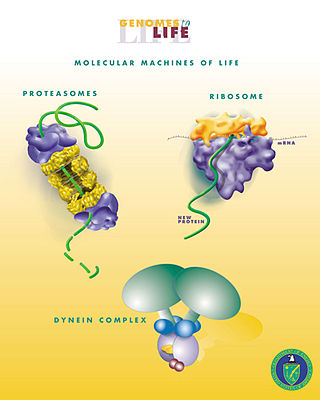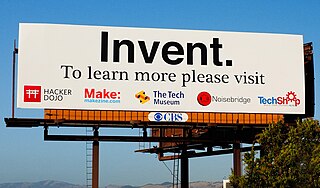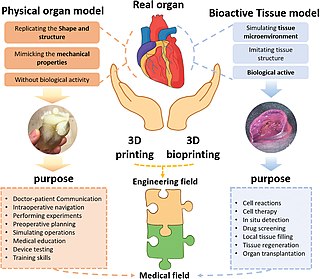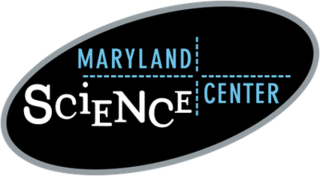
A fab lab is a small-scale workshop offering (personal) digital fabrication.

Biological engineering or bioengineering is the application of principles of biology and the tools of engineering to create usable, tangible, economically viable products. Biological engineering employs knowledge and expertise from a number of pure and applied sciences, such as mass and heat transfer, kinetics, biocatalysts, biomechanics, bioinformatics, separation and purification processes, bioreactor design, surface science, fluid mechanics, thermodynamics, and polymer science. It is used in the design of medical devices, diagnostic equipment, biocompatible materials, renewable energy, ecological engineering, agricultural engineering, process engineering and catalysis, and other areas that improve the living standards of societies.

The Methuselah Foundation is an American-based global non-profit organization based in Springfield, Virginia, with a declared mission to "make 90 the new 50 by 2030" by supporting tissue engineering and regenerative medicine therapies. The organization was originally incorporated by David Gobel in 2001 as the Performance Prize Society, a name inspired by the British governments Longitude Act, which offered monetary rewards for anyone who could devise a portable, practical solution for determining a ship's longitude.

A hackerspace is a community-operated, often "not for profit", workspace where people with common interests, such as computers, machining, technology, science, digital art, or electronic art, can meet, socialize, and collaborate. Hackerspaces are comparable to other community-operated spaces with similar aims and mechanisms such as Fab Lab, men's sheds, and commercial "for-profit" companies.

DIYbio is an informal umbrella organization for individuals and local groups active in do-it-yourself biology, encompassing both a website and an email list. It serves as a network of individuals from around the globe that aims to help make biology a worthwhile pursuit for citizen scientists, biohackers, amateur biologists, and do-it-yourself biological engineers who value openness and safety. It was founded by Jason Bobe and Mackenzie Cowell in 2008.

David Gobel is an American philanthropist, entrepreneur, inventor, and futurist. He is co-founder and CEO of the Methuselah Foundation, CEO of the Methuselah Fund, and one of the first to publicly advance the idea of longevity escape velocity, even before this term was formulated.
Do-it-yourself biology is a biotechnological social movement in which individuals, communities, and small organizations study biology and life science using the same methods as traditional research institutions. DIY biology is primarily undertaken by individuals with limited research training from academia or corporations, who then mentor and oversee other DIY biologists with little or no formal training. This may be done as a hobby, as a not-for-profit endeavor for community learning and open-science innovation, or for profit, to start a business.

The maker culture is a contemporary subculture representing a technology-based extension of DIY culture that intersects with hardware-oriented parts of hacker culture and revels in the creation of new devices as well as tinkering with existing ones. The maker culture in general supports open-source hardware. Typical interests enjoyed by the maker culture include engineering-oriented pursuits such as electronics, robotics, 3-D printing, and the use of computer numeric control tools, as well as more traditional activities such as metalworking, woodworking, and, mainly, its predecessor, traditional arts and crafts.

Three dimensional (3D) bioprinting is the utilization of 3D printing–like techniques to combine cells, growth factors, and/or biomaterials to fabricate biomedical parts, often with the aim of imitating natural tissue characteristics. Generally, 3D bioprinting can utilize a layer-by-layer method to deposit materials known as bio-inks to create tissue-like structures that are later used in various medical and tissue engineering fields. 3D bioprinting covers a broad range of bioprinting techniques and biomaterials. Currently, bioprinting can be used to print tissue and organ models to help research drugs and potential treatments. Nonetheless, translation of bioprinted living cellular constructs into clinical application is met with several issues due to the complexity and cell number needed to create functional organs. However, innovations span from bioprinting of extracellular matrix to mixing cells with hydrogels deposited layer by layer to produce the desired tissue. In addition, 3D bioprinting has begun to incorporate the printing of scaffolds which can be used to regenerate joints and ligaments.
Prof. İbrahim Tarık Özbolat is a Turkish scientist and academic at the Pennsylvania State University. He specializes in manufacturing and tissue engineering, with numerous articles published in the context of bioprinting. He received his Ph.D. in Industrial and Systems Engineering from University at Buffalo, The State University of New York, New York, and dual B.S. degrees in Mechanical Engineering and in Industrial Engineering from Middle East Technical University Ankara, Turkey. He is the principal investigator for the Ozbolat Lab in the Millennium Science Complex at the Huck Institute of the Life Sciences.

M3D, LLC is an American manufacturer of 3D printers in Fulton, Maryland. The company's flagship product is the "Micro 3D" or "Micro".
BioCurious is a community biology laboratory and nonprofit organization located in Sunnyvale, California, co-founded by Eri Gentry, Kristina Hathaway, Josh Perfetto, Raymond McCauley, Joseph Jackson, and Tito Jankowski. With the help of Kickstarter and 239 backers they raised $35,319. BioCurious is a complete working laboratory and technical library for entrepreneurs to access equipment, materials, and co-working space, and a meeting place for citizen scientists, hobbyists, activists, and students. Scientific American magazine has described BioCurious as "one of country’s premier community biotechnology labs [...]".
Makers Empire 3D is a 3D modeling computer program made by Makers Empire. It is designed to introduce 4-13 year old students to Design Thinking and engage them in STEM learning via 3D design and 3D printing. The 3D app is optimized for touch screens but can be used with and without a mouse on all major platforms.
The Victoria Makerspace is a biology community lab, founded by Derek Jacoby and Thomas Gray in 2010, and was one of the first do-it-yourself biology labs, following the establishment of BioCurious and Genspace in the US. The lab has taken part in the FBI DIY biology summit in Walnut Creek, California in 2012, the first Canadian DIY Biology Summit in 2016, and the iGEM synthetic biology competition in 2014 with a project on preventing dental decay.

SteamHead is a non-profit organization whose stated goal is to "increase the presence of design in education". SteamHead claims inspiration from the Maker movement and S.T.E.A.M. education. Initiatives credited to SteamHead aim to help communities increase their capacity to "make". Activities are supported sponsors including the British Council, local charities, and schools. The organization supports local events including MakeFashion Edu and School Maker Faires.
Ellen D. Jorgensen is a New York-based molecular biologist leading the do-it-yourself biology movement. She works to increase scientific literacy in the general population, particularly in the fields of molecular and synthetic biology. She is a co-founder of both Biotech Without Borders and Genspace. In 2017, Ellen Jorgensen was named one of the Most Creative Leaders in Business by Fast Company.
NextFab Studio, LLC is a network of membership-based makerspaces with locations in Philadelphia and Wilmington. Founded in 2009 by Evan Malone, the for-profit company opened its first location in West Philadelphia’s University City Science Center.
Brittany Young is an engineer, STEM educator, and 2020 TED fellow. She is the founder and chief executive officer of B-360, an education program that supports under-served youth. She was the 2018 Echoing Green Black Male Achievement Fellow.

Microgravity bioprinting is the utilization of 3D bioprinting techniques under microgravity conditions to fabricate highly complex, functional tissue and organ structures. The zero gravity environment circumvents some of the current limitations of bioprinting on Earth including magnetic field disruption and biostructure retention during the printing process. Microgravity bioprinting is one of the initial steps to advancing in space exploration and colonization while furthering the possibilities of regenerative medicine.











